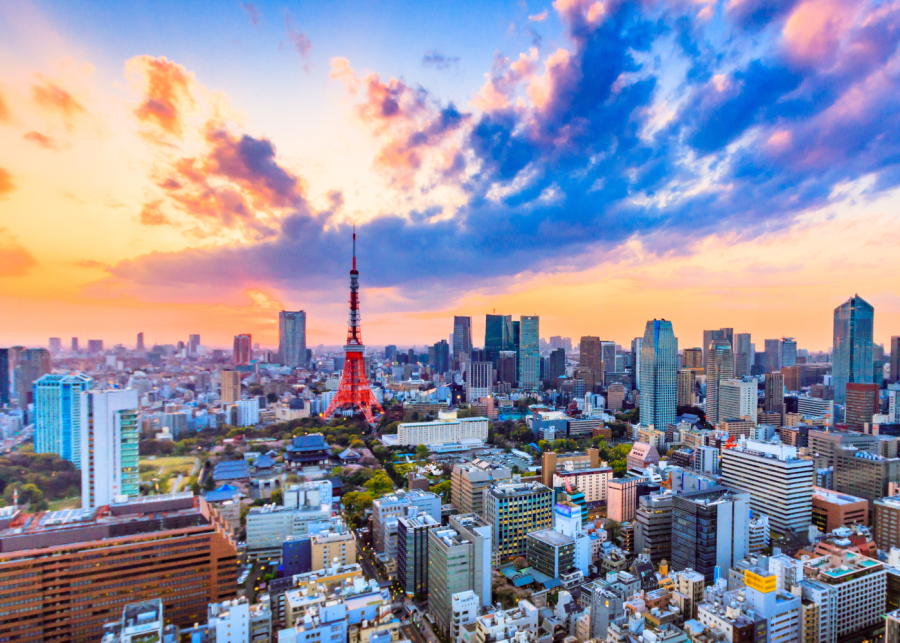
Explore historic towns, breathtaking nature spots and cultural treasures on the best day trips from Tokyo.
From serene coastal retreats to enchanting mountain landscapes, the best day trips from Tokyo offer a glimpse into Japan’s rich history, vibrant culture and gorgeous natural beauty. Tokyo is the perfect base for exploring Japan, thanks to its top-notch train system.
Tip: for nearby day trips, get a Tokyo Wide Pass for popular spots like Nikko and Hakone, or use a Suica or Pasmo card for seamless travel on local trains and buses. Ready to explore? These are the best day trips from Tokyo.
Best day trips from Tokyo
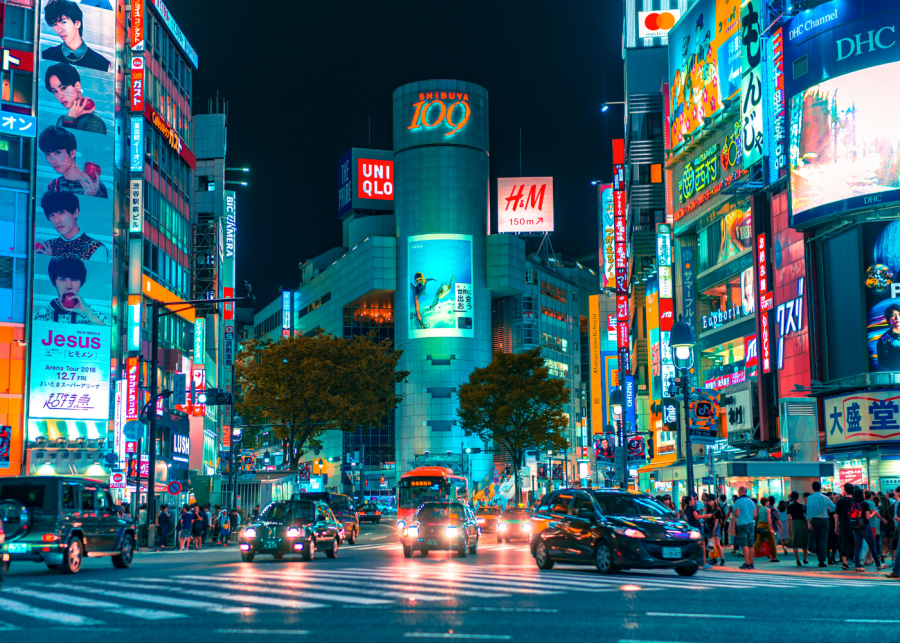
1. Yokohama

Located south of Tokyo, Yokohama is a dynamic city that blends history, modern attractions and seaside beauty. Known as one of Japan’s largest port cities, it boasts a cosmopolitan atmosphere, unique neighbourhoods and rich cultural experiences.
What Yokohama is known for:
- Minato Mirai 21: Stroll along this picturesque waterfront district, home to the iconic Landmark Tower, shopping centres and the majestic Cosmo Clock 21 Ferris wheel.
- Yokohama Chinatown: Savour authentic Chinese dishes like dim sum, fluffy pork buns and delicious sesame dumplings in the largest Chinatown in Japan.
- Cup Noodles Museum: A fun, interactive museum where you can create customised cup noodles and learn about its history.
- Sankeien Garden: Escape the hustle and bustle in this serene traditional Japanese garden filled with historic buildings and seasonal blooms.
- Shin-Yokohama Ramen Museum: Taste ramen from different regions of Japan in a retro-themed setting.
- Osanbashi Pier: Admire panoramic views of the port and the city skyline – it’s especially beautiful during sunset.
How to get to Yokohama from Tokyo station:
- Take the JR Tokaido line or JR Yokosuka line to Yokohama station.
- Travel time: 25 to 30 minutes.
- Price for a one-way trip: Approximately ¥480 (approx $4).
2. Kamakura

Just an hour from Tokyo, Kamakura offers a mix of culture and nature. A peaceful escape for exploring ancient shrines and temples or enjoying the beauty of its gardens, it’s famous for its stunning hydrangea blooms in June, when the city becomes a colourful garden. Don’t miss out on local delicacies like shirasu (fresh baby sardines) and kama mochi (steamed rice cakes).
What Kamakura is known for:
- The Great Buddha (Daibutsu): This must-see bronze statue stands 13.35 metres tall at Kotoku-in Temple.
- Tsurugaoka Hachimangu Shrine: A beautiful shrine with vibrant hydrangeas in June.
- Meigetsu-in Temple (The Hydrangea Temple): Home to over 2,500 hydrangeas, it’s one of the best spots for blooms in Kamakura. Get there early during peak season to avoid the crowds.
- Hasedera Temple: Known for its giant Kannon statue and lovely hydrangea-filled gardens.
- Komachi-dori Street: Explore this bustling street for local food and enjoy hydrangea-themed treats.
- Cafe Yoridokoro: Enjoy homemade treats, from rich coffee to savoury dishes, in this charming spot with peaceful views of the train tracks. P.S. you can whip your own egg whites to top off your rice here!
How to get to Kamakura from Tokyo station:
- Take the JR Yokosuka line directly to Kamakura station.
- Travel time: About one hour.
- Price for a one-way trip: Around ¥945 (approx $8).
3. Enoshima
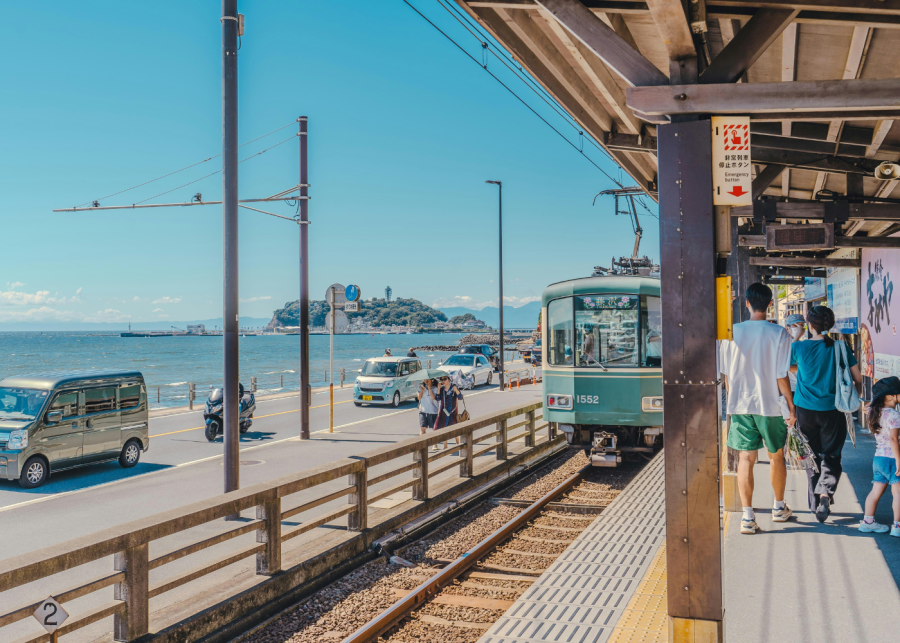
This little island off the coast of Kanagawa is packed with stunning views, delicious food and fun activities. Enoshima is like a breath of fresh air. It’s a serene yet lively place where you can soak up the sun, wander through quaint shrines and eat your weight in seafood.
What Enoshima is known for:
- Enoshima Shrine: Dedicated to Benzaiten, the goddess of music and good fortune, it’s a peaceful place to reflect and take in the views.
- Enoshima Sea Candle: No visit to Enoshima is complete without heading to this lighthouse for a 360-degree view of the island, the ocean and, if you’re lucky, Mount Fuji in the distance.
- Iwaya Caves: Feeling adventurous? Head to the mystical Iwaya Caves, where legend meets nature. When you get to the dragon statue at the end of the cave, clap your hands to make it roar!
- Beaches and water fun: The beaches here are perfect for those who want to surf, swim, or chill out by the water.
- Enoshima Aquarium: Great for families and animal lovers, the Enoshima Aquarium features exhibits that range from playful penguins to adorable seals.
- Seafood dishes: Enoshima is known for its fresh seafood, especially the local shirasu (fresh baby sardines), which you can enjoy in dishes like rice bowls or on top of a fresh sushi platter.
How to get to Enoshima from Tokyo station:
- Take the JR Tokaido line to Fujisawa station, then transfer trains from Fujisawa station to Enoshima station on the Enoden line.
- Travel time: One hour and ten minutes.
- Price for a one-way trip: ¥1210 (approx $10)
4. Hakone
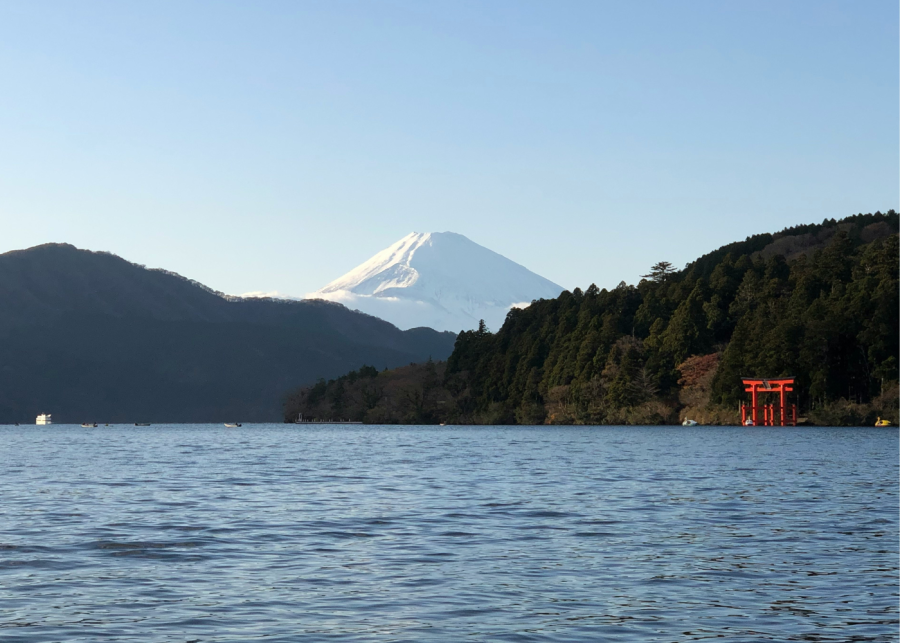
Hakone, a charming town nestled in the mountains of Kanagawa Prefecture, is one of Japan’s most popular destinations for a relaxing getaway. Known for its soothing hot springs (onsen), stunning views of Mount Fuji, and an array of cultural and natural attractions, Hakone is a haven for those seeking to unwind while immersing in Japanese culture and nature.
What Hakone is known for:
- Lake Ashi (Ashinoko): Take a scenic boat cruise and enjoy picturesque views of Mount Fuji on clear days.
- Hakone Shrine: This shrine exudes spiritual serenity and is famous for its red torii gate standing in the lake.
- Open-Air Museum: A fusion of art and nature, this museum showcases incredible sculptures against magnificent mountain views. There’s even a hot foot bath service located inside the museum’s cafe.
- Owakudani Valley: Ride the ropeway up the mountains to experience the steaming volcanic vents and try the famous black eggs (kuro-tamago) – they’re believed to add years to your life.
- Yumoto Onsen: Relax in one of Hakone’s oldest and most renowned hot spring areas.
- Local cuisine: Don’t miss local dishes like soba noodles, tofu and onsen tamago (eggs cooked in hot spring water).
How to get to Hakone from Tokyo station:
- Take the Tokaido line to Odawara station. Transfer to the Hakone Tozan bus, drop off at the Miyaginobashi stop and walk ten minutes to Gora station.
- Travel time: Approximately two hours and ten minutes.
- Price for a one-way trip: ¥2408 (approx $20).
5. Mount Takao

Mount Takao is a hiker’s haven and an easy introduction to Japan’s natural beauty, as it’s home to well-maintained trails for all fitness levels. In autumn, the mountain transforms into a vibrant display of fiery red and orange foliage, while springtime is perfect for cherry blossom viewing. You can enjoy local delicacies like tengu-yaki (a red bean-filled cake shaped like the mountain’s mythical guardian) and fresh soba noodles at the summit, or spot Mount Fuji on a clear day.
What Mount Takao is known for:
- Hiking trails: Trail 1 is the most popular for its paved path and stops at Yakuoin Temple and scenic viewpoints. Download and use the “AllTrails” app to plan your hiking route and level.
- Yakuoin Temple: Immerse yourself in history and pray for good fortune while admiring the intricate carvings and vibrant decorations.
- Cable car or chairlift ride: Not a fan of hiking? Take the steepest cable car in Japan or enjoy the open-air chairlift for a more relaxed ascent.
- Takao Beer Mount: From summer to early autumn, enjoy craft beer and a buffet spread while soaking in the views at the mountaintop beer garden.
How to get to Mount Takao from Tokyo station:
- Take the Chuo line to Shinjuku station, then transfer to the Keio line for a quick ride to Takaosanguchi station.
- From Takaosanguchi station, the mountain base and cable car station are a short walk away.
- Travel time: One hour and 15 minutes.
- Price for a one-way trip: ¥1128 (approx $10).
6. Kawagoe
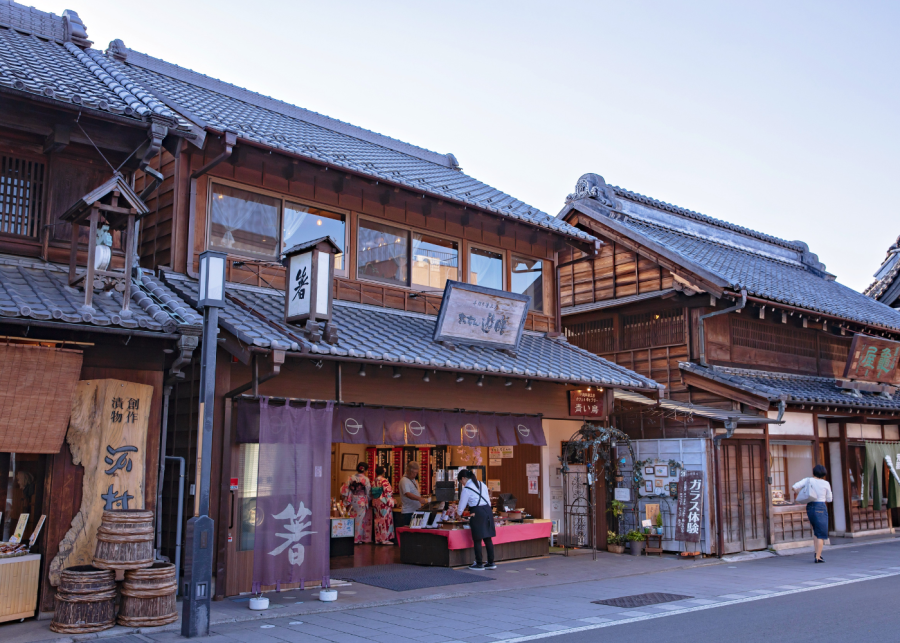
Kawagoe, often called “Little Edo,” is a charming city in Saitama Prefecture, just a short day trip from Tokyo. Known for its well-preserved Edo-period architecture, Kawagoe transports visitors back in time with its cobbled streets and traditional wooden warehouse-style buildings called “kurazukuri”. It’s also a great spot for shopping, with local craft shops and vendors selling traditional sweets, especially the famous sweet potato snacks.
What Kawagoe is known for:
- Toki no Kane (Bell Tower): This iconic landmark, dating back to the 17th century, chimes every hour and is a symbol of Kawagoe.
- Kawagoe Hikawa Shrine: The sacred site famous for its connection to love and fortune offers visitors a peaceful retreat.
- Kurazukuri Street: Walk through this historic street lined with clay-walled merchant houses to get a real sense of Kawagoe’s past.
- Kawagoe Festival: One of Japan’s most colourful festivals, this is celebrated in October and known for its elaborate floats, traditional performances and vibrant atmosphere.
- Sweets shops: Kawagoe is famous for its “kibi-dango” (sweet rice flour treats) and other traditional Japanese sweets.
How to get to Kawagoe from Tokyo station:
- Take the Marunouchi line to Ikebukuro station, then transfer to the Tobu-Tojo line and alight at Kawagoe station.
- Travel time: 53 minutes.
- Price for a one-way trip: ¥690 (approx $6).
7. Ashikaga Flower Park

Ashikaga Flower Park is famous for its wisteria, which is known locally as fuji. The park features an awe-inspiring 150-year-old wisteria tree, vibrant hanging wisteria tunnels, and a magical illumination event in winter that has earned recognition as one of Japan’s top light displays. With seasonal blooms year-round, from tulips and roses to hydrangeas and sunflowers, there’s always something to delight visitors.
What Ashikaga Flower Park is known for:
- Wisteria tunnels: Walk under cascades of purple, white and pink wisteria blossoms from April to May.
- Light displays: The park transforms into a glittering wonderland with millions of LED lights from November to February.
- Seasonal gardens: Explore the park’s landscapes showcasing seasonal flowers like peonies, azaleas and more.
- Local delicacies: Don’t miss the wisteria-themed sweets, such as wisteria-flavoured ice cream and wisteria-shaped pastries available at the park.
- Souvenir shops: Pick up unique wisteria-inspired goods as keepsakes of your visit.
How to get to Ashikaga Flower Park from Tokyo station:
- Take the JR Utsunomiya line to Oyama station, then transfer to the JR Ryomo line and get off at Ashikaga Flower Park station.
- Travel time: Approximately two hours and eight minutes.
- Price for a one-way trip: ¥1980 (approx $17).
8. Nikko
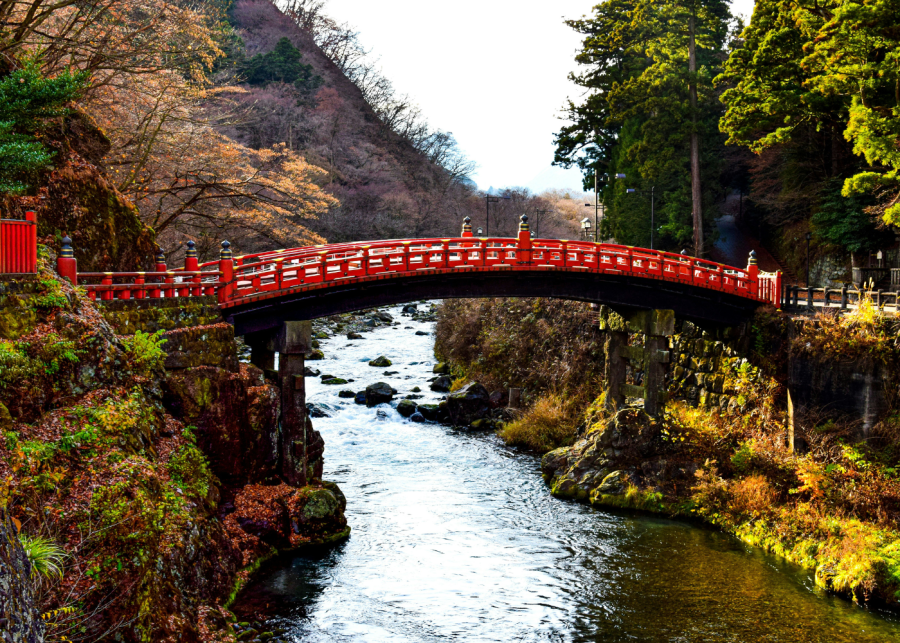
Nikko, nestled in Tochigi Prefecture, is a breathtaking fusion of natural beauty and cultural heritage. Known for its Unesco World Heritage Sites, including the ornate Toshogu Shrine, it’s a must-visit day trip from Tokyo. The area is especially stunning during autumn when the vibrant foliage transforms the landscape into a painter’s palette.
What Nikko is known for:
- Toshogu Shrine: This lavishly decorated Shinto shrine is dedicated to Tokugawa Ieyasu, the founder of the Tokugawa shogunate.
- Kegon Falls: One of Japan’s most famous waterfalls, it’s a sight to behold year-round.
- Lake Chuzenji: A picturesque lake surrounded by mountains, it’s ideal for a relaxing stroll or boat ride.
- Edo Wonderland: The theme park lets you step back into Japan’s Edo period with traditional costumes, samurai shows and ninja performances.
- Local delicacies: Try yuba (tofu skin) dishes, a specialty of the area, and the local sake brewed with Nikko’s pristine mountain water.
How to get to Nikko from Tokyo station:
- Take the JR Tohoku Shinkansen to Utsunomiya station, then transfer to the JR Nikko line and alight at Nikko station.
- Travel time: About one hour and 45 minutes.
- Price for a one-way trip: ¥5,000 – ¥6,000 (covered by the JR Pass, approx $43 – $52).
9. Chichibu
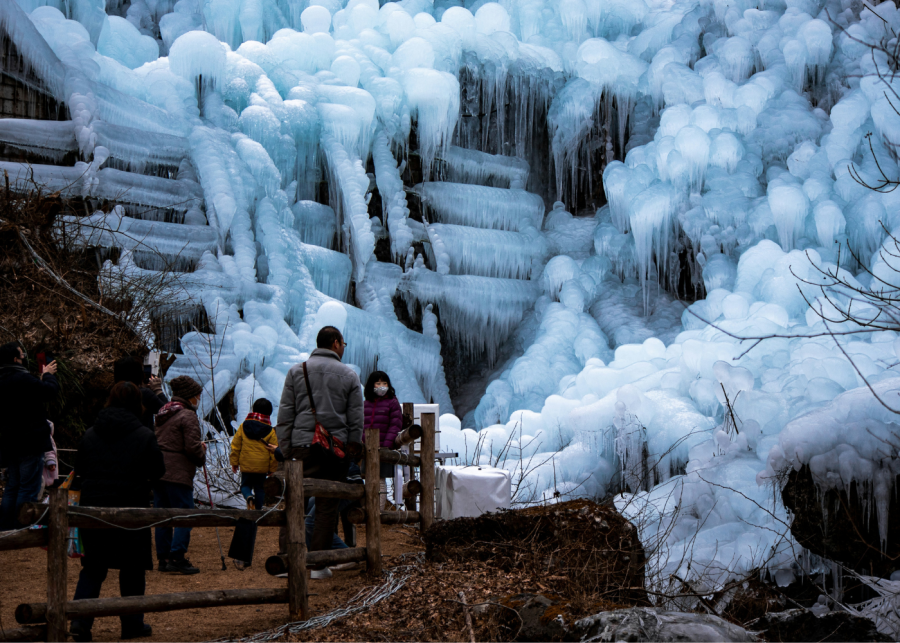
Known for its picturesque landscapes, traditional festivals and unique culinary offerings, Chichibu provides a tranquil yet exciting escape from Tokyo’s fast-paced lifestyle. Whether you’re looking to admire spring blooms or enjoy a magical winter wonderland, this destination offers something special year-round.
What Chichibu is known for:
- Shibazakura no Oka (Pink Moss Hill): Located in Hitsujiyama Park, this vibrant pink carpet of pink moss phlox is a must-see in spring (mid-April to early May). With the Chichibu mountains as a backdrop, it’s a photographer’s dream.
- Icicles of Ashigakubo: Marvel at these magical natural ice formations in winter – they’re best seen from January to mid-February, with evening illuminations adding to their charm.
- Mitsumine Shrine: The spiritual sanctuary is surrounded by lush forests and offers panoramic mountain views.
- Nagatoro Gorge: Perfect for relaxing riverboat rides, hiking and enjoying the seasonal foliage.
- Chichibu distillery: A paradise for whisky lovers, it produces world-renowned Chichibu whisky.
- Local cuisine: Treat yourself to waraji katsu (giant pork cutlets served on rice) and misomato udon (a comforting miso-flavoured noodle dish).
How to get to Chichibu from Tokyo station:
- Take the Marunouchi line to Ikebukuro station, then transfer to the Seibu Ikebukuro line to Seibu-Chichibu station. Chichibu station is a 19-minute walk from there.
- Travel time: Approximately two hours.
- Price for a one-way trip: Around ¥2,000 (approx $17).
10. Okutama
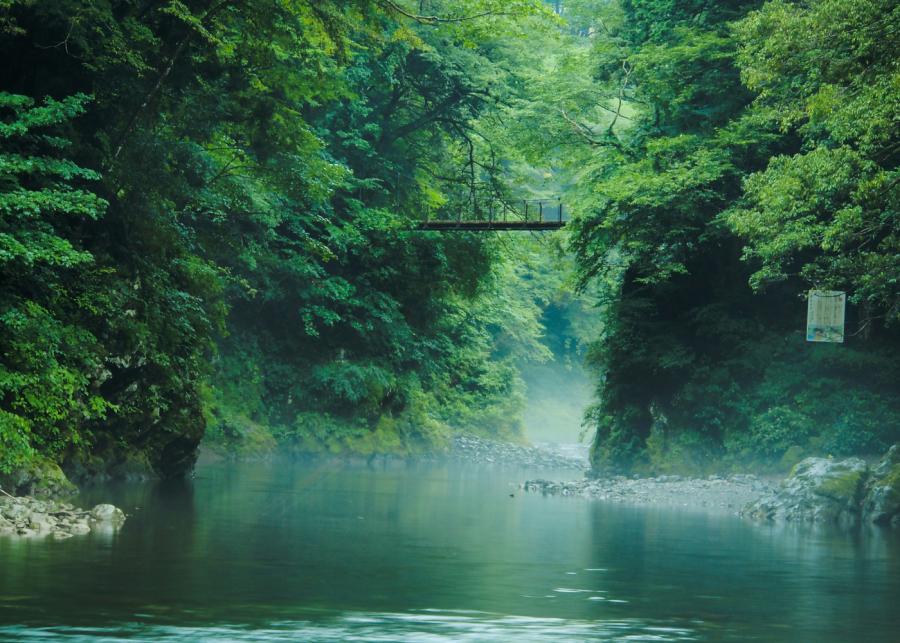
Okutama is a haven for hiking, camping and water sports enthusiasts. Its lush forests, crystal clear rivers and majestic mountains create the ideal backdrop for a weekend getaway. Take a day trip here from Tokyo to conquer scenic trails, dip in refreshing streams, or unwind with lovely views.
What Okutama is known for:
- Hiking the Mount Mitake trail: Explore the iconic mountain trails leading to Musashi-Mitake shrine and enjoy panoramic views of the Kanto region.
- Lake Okutama: A tranquil reservoir surrounded by forests, it’s perfect for a peaceful stroll or a picnic.
- Nippara limestone cave: Marvel at the natural limestone formations in this cool, atmospheric cave.
- Hatonosu Valley: Wander along the valley’s picturesque walking paths and enjoy the sound of the rushing Tama River.
- Local eats: Try fresh river fish like ayu (sweetfish) or hearty soba noodles at traditional mountain inns.
How to get to Okutama from Tokyo station:
- Take the JR Chuo line (rapid) to Tachikawa station; transfer to the JR Ome line at Tachikawa station for Okutama station.
- Travel time: two hours and 28 minutes.
- Price for a one-way trip: ¥1,180 (approx $10).
11. Zao Fox Village

This enchanting sanctuary is home to over 100 foxes, and you can observe these curious creatures up close in a semi-wild habitat. Foxes, or kitsune, are regarded as mystical creatures in Shinto mythology, symbolising wisdom and protection. Zao Fox Village allows visitors to interact with and learn about six different playful and photogenic fox species. The chance to feed and photograph these adorable animals in a natural setting makes it an unforgettable day trip from Tokyo!
Tip: start your trip in the morning so you’ll have ample time to explore, and dress warmly as it gets cold during winter. Remember to follow the rules when interacting with the foxes, as they’re wild animals and should be treated with care.
What Zao Fox Village is known for:
- Fox interaction area: Stroll through an open area where foxes roam freely, observe their playful antics or snap memorable photos.
- Learning centre: Discover fascinating facts about the life and behaviour of foxes.
- Scenic nature walks: The village is set against the backdrop of Zao’s pristine mountains, offering gorgeous scenery throughout the seasons.
- Local delights: Try regional specialties like gyutan (grilled beef tongue) or warm up with a bowl of hearty miso ramen.
How to get to Zao Fox Village from Tokyo station:
- Take the Tohoku Shinkansen to Shiroishi-Zao station, then take a taxi to Zao Fox Village. Alternatively, check for local buses that connect to the area (availability may vary, so plan ahead).
- Travel time: Around two hours and 41 minutes one-way.
- Price for a one-way trip: ¥15,000 (approx $130).
12. Hitachi Seaside Park

Located in Ibaraki Prefecture, Hitachi Seaside Park is a mesmerising destination known for its seasonal flowers, sprawling landscapes and coastal charm. Spanning over 190 hectares, this park is famous in spring for its nemophila (baby blue eyes), which paints the hills in dreamy shades of blue, and kochia (bassia or summer cypress) in autumn, when the hills glow red. It also features cycling trails, an amusement park and plenty of picnic areas, making it a perfect day trip from Tokyo for families, couples and solo travellers.
What Hitachi Seaside Park is known for:
- Miharashi Hill: Visitors come for its waves of nemophila or kochia plants, depending on the season.
- Cycling paths: Rent a bike to explore the park’s vast grounds.
- Rokkakudo Pavilion: This is a historic red hexagonal building with panoramic ocean views.
- Local eats: Try Ibaraki specialties like Hitachi beef croquettes and melon-flavoured ice cream served near the park. You can even get seasonal ice cream flavours like nemophila ones!
How to get to Hitachi Seaside Park from Tokyo station:
- Take the JR Joban line to Katsuta station and hop on a 20-minute bus ride to Hitachi Seaside Park.
- Travel time: Two hours and 47 minutes.
- Price for a one-way trip: ¥4,290 (approx $37).
13. Ushiku Daibutsu
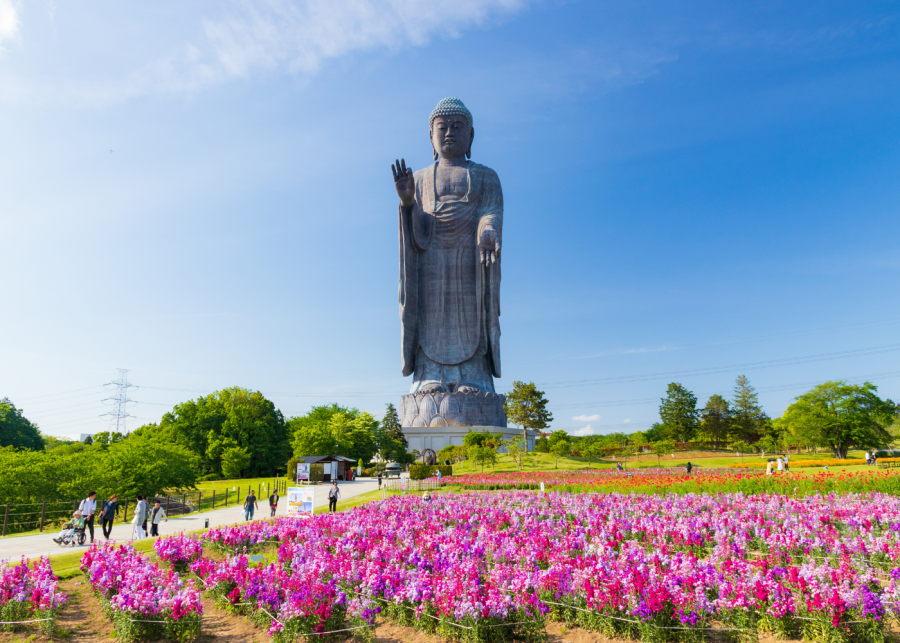
Standing tall as one of the world’s largest statues, Ushiku Daibutsu in Ibaraki Prefecture is a must-see destination for travellers looking to experience Japan’s serene spiritual heritage and awe-inspiring architecture. At a towering 120 metres, this bronze statue of the Buddha is nearly three times taller than New York’s Statue of Liberty!
What Ushiku Daibutsu is known for:
- The statue and observation decks: Ride the elevator up to the observation floors inside the statue (up to 85 metres high) to enjoy sweeping views of the surrounding countryside and even Mount Fuji on a clear day.
- Beautiful gardens: Surrounding the statue, you’ll find seasonal flower gardens, koi ponds and pathways perfect for strolling. The cherry blossoms in spring and vibrant cosmos in autumn are gorgeous.
- Buddhist exhibits: Inside the statue, explore exhibits on Buddhist teachings and the history of the monument, along with tranquil spaces for reflection.
- Koi feeding and animal petting zoo: A great activity for families or animal lovers, here’s where you can purchase food to feed the colourful koi fish or spend time with small animals like bunnies and goats.
- Local eats: Try local specialties like Hitachi beef (if you’re a meat lover) and delicious snacks like matcha ice cream to cool off on a sunny day.
How to get to Ushiku Daibutsu from Tokyo station:
- Take the JR Joban line to Ushiku station and hop on a 30-minute bus (bound for Ushiku Daibutsu) or take a short taxi ride.
- Travel time: One hour and 50 minutes.
- Price for a one-way trip: About ¥1,120 (approx $10).
14. Shiofune Kannon-ji
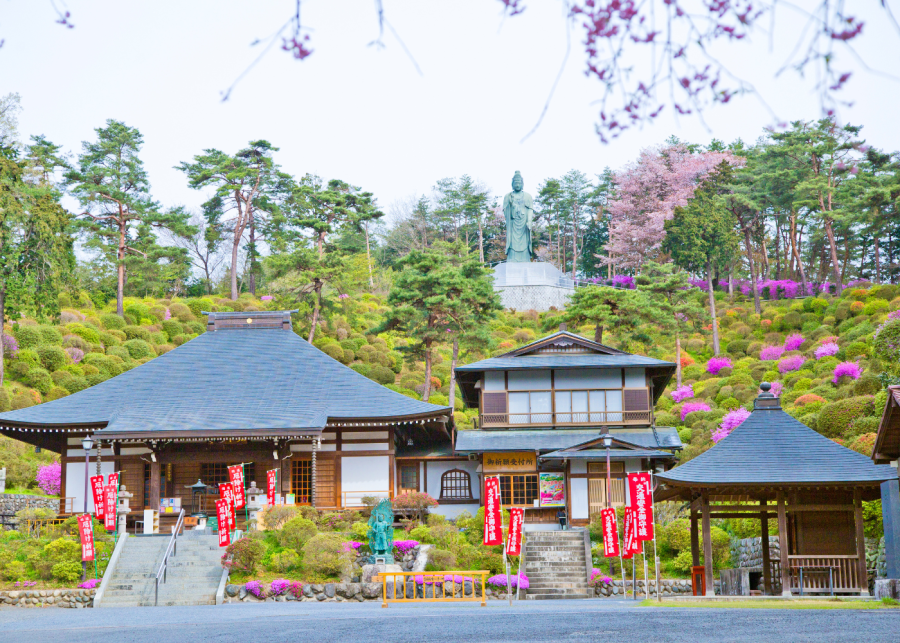
Shiofune Kannon-ji is a serene Buddhist temple renowned for its breathtaking azalea gardens and peaceful atmosphere. Known as one of the best spots to experience Japan’s azalea season, the temple attracts visitors with its colourful blooms in spring.
From late April to mid-May, the temple grounds transform into a kaleidoscope of colours as over 17,000 azalea bushes burst into bloom. The view from the observation deck, overlooking the rolling hills covered in vivid pinks, reds and whites, is truly magical. Outside of azalea season, the temple provides a peaceful retreat with its towering 25m-tall bronze statue of Kannon, the Buddhist Goddess of Mercy, watching over the lush surroundings.
What Shiofune Kannon-ji is known for:
- Azalea gardens: Visit during spring to witness the stunning sea of azaleas that surround the temple grounds.
- Kannon statue: Marvel at the bronze statue, a symbol of compassion.
- Meditative walks: Wander along the tranquil forest paths for a moment of introspection.
- Temple rituals: Experience the serene chanting of monks or light incense as part of a traditional temple visit.
- Local eats: Nearby, Ome offers a taste of countryside flavours, with fresh soba noodles and mountain vegetables at family-run restaurants.
How to get to Shiofune Kannon-ji from Tokyo station:
- Take the JR Chuo line to Ozaku station. Transfer to the number 11 bus from Ozaku Eki Higashiguchi. The temple is a nine-minute walk from the bus stop.
- Travel time: About one hour and 37 minutes.
- Price for a one-way trip: ¥1,200 (approx $10).
15. Jogasaki Coast
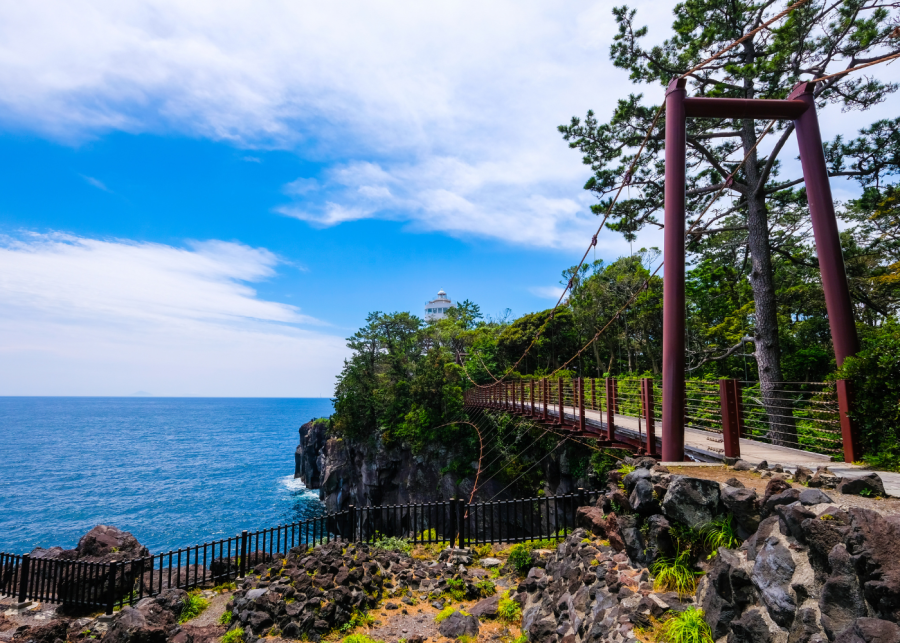
Located on the eastern edge of the Izu Peninsula in Shizuoka Prefecture, Jogasaki Coast is a stretch of rugged coastline framed by dramatic cliffs, lush greenery and the endless blue of the Pacific Ocean. It’s famous for its 10km hiking trail that winds through volcanic rock formations, offering panoramic ocean views. The area is also less crowded than other coastal spots, making it an ideal destination for those seeking a tranquil escape from Tokyo.
What Jogasaki Coast is known for:
- Jogasaki Suspension Bridge (Kadowakitsuri-bashi): A thrilling walk over this iconic 23m-high suspension bridge gives you an unparalleled view of the rocky coastline below.
- Jogasaki nature trail: A moderate hiking route lined with picturesque cliffs, wildflowers and lighthouses, it’s beginner-friendly but equally rewarding for experienced hikers.
- Mount Omuro: The nearby dormant volcano with a crater you can walk around offers 360-degree views of the Izu Peninsula and beyond.
- Seafood delights: Enjoy fresh seafood like Izu spiny lobster, abalone and wasabi-flavoured delicacies at local eateries.
How to get to Jogasaki Coast from Tokyo station:
- Take the JR Tokaido line to Atami station, transfer to the Ito line and get off at Jogasaki-Kaigan station.
- Travel time: Approximately 2 hours.
- Price for a one-way trip: About ¥4,000 (approx $25).
Pack your bag, grab your camera and get ready to explore on these day trips from Tokyo!


